-
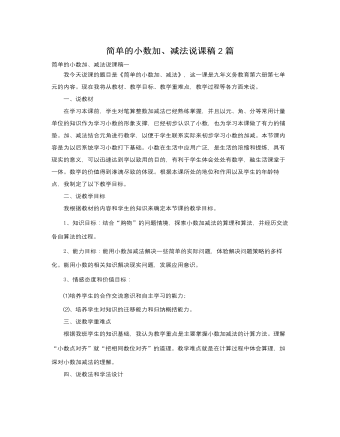
人教版新课标小学数学三年级下册简单的小数加、减法说课稿2篇
师:希望大家开动脑筋,大胆猜想,看谁能根据自己已有的生活经验和知识经验,发现小数加减法计算的方法,并说明其中的道理。出示图片。师:从图中了解到什么信息?(学生自由介绍)师:这些小数都认识吗?谁来谈谈对这些小数的认识。提问:小数点后面的“5”表示什么?小数点前面的2表示什么意思?3.师:根据这些信息你能提出哪些数学问题?根据学生回答教师板书解决问题的算式。选择一个问题研究。(三)探究算理1.尝试计算并说明理由。(选择12.5+3.6=板书)学生先尝试用自己的方法解决,把不同的方法板演在黑板上。2.学生反馈、组织评价。先让生自己说计算过程和想法,并给予点评,再重点讲解笔算的方法和算理。3.探究小数的减法。师:根据小数加法的经验,减法能独立解决吗?学生独立解决问题。反馈时展示学生不同的计算方法。评价时注重引导学生说说是怎样想的,引导学生说清算理。强调整数部分“0”的处理。
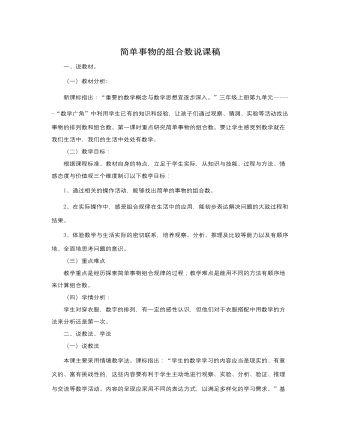
人教版新课标小学数学三年级下册简单事物的组合数说课稿
4、幸运碰撞文文选了一条近的路,然后顺利的来到了猴山。但是猴山的门被设置了密码,密码是由两位数组成,十位上是2、4、9这三个数中的任意一个,个位上是3、6、8三个数中的任意一个,文文最少几次,最多几次可以打开门呢?组织学生小组合作利用卡片拉一拉,并记录结果,全班交流。根据学生汇报,板书组合结果。5、拍照留念看到小朋友们玩得这么开心,聪聪和明明也来了。他们还带来了照相机,在这美好的时刻,新的问题又随之而来:四个小朋友每人都要和聪聪、明明单独各合一张影,一共要照多少张照片呢?孩子们可以在小组内扮演角色,记录不同的方法,还让学生当小摄影师,其余同学来评价。(三)汇报收获,拓展内化。请同学们回顾一下这节课都解决了哪些问题?怎样解决的?学生汇报完后,强调:在搭配中要做到既不重复又不遗漏就必须按一定的顺序进行观察、操作。在今后的学习生活中还会遇到许多这样的问题,鼓励学生只要发挥自己的聪明才智就一定能解决出来。
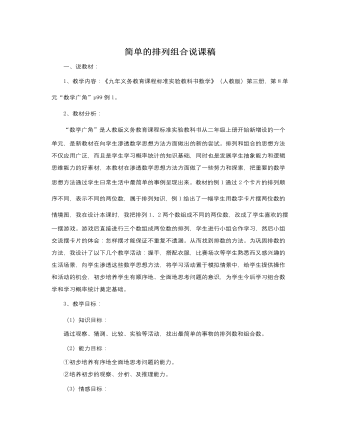
人教版新课标小学数学三年级上册简单的排列组合说课稿
五、说反思:通过本节课的学习,我预期学生达到如下的效果:1、培养学生的全面地思考问题和观察、分析及推理能力。通过摆数字卡片、握手、服装搭配等活动,培养学生多渠道获取信息的能力,从中培养学生的全面地思考问题和观察、分析及推理等实践能力。2、培养师生的合作意识和合作能力。通过师生、生生的交流和交往,开展各种灵活多样的研究活动,有利于提高学生的交际能力和表达能力。有利于培养学生的合作意识和合作能力。3、激励参与,培养学生的主动性。在摆数字、握一握、搭配服装的时候,几个学生一个小组围在一起,小声讨论研究。每个题目都先由学生分析、讨论,教师不失时机地追问,鼓励学生积极参与,激发学生的创新思维。鼓励学生充分表现自己,增强自信,发挥创造性思维,培养初步培养有序地、全面地思考问题的能力和初步的观察、分析、及推理能力,激发了学生的参与意识。
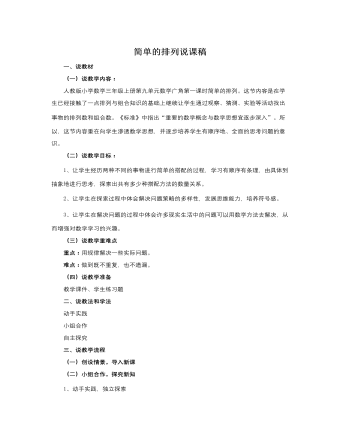
人教版新课标小学数学三年级上册简单的排列说课稿
一、说教材(一)说教学内容:人教版小学数学三年级上册第九单元数学广角第一课时简单的排列。这节内容是在学生已经接触了一点排列与组合知识的基础上继续让学生通过观察、猜测、实验等活动找出事物的排列数和组合数。《标准》中指出“重要的数学概念与数学思想宜逐步深入”。所以,这节内容重在向学生渗透数学思想,并逐步培养学生有顺序地、全面的思考问题的意识。(二)说教学目标:1、让学生经历两种不同的事物进行简单的搭配的过程,学习有顺序有条理,由具体到抽象地进行思考,探索出共有多少种搭配方法的数量关系。2、让学生在探索过程中体会解决问题策略的多样性,发展思维能力,培养符号感。3、让学生在解决问题的过程中体会许多现实生活中的问题可以用数学方法去解决,从而增强对数学学习的兴趣。
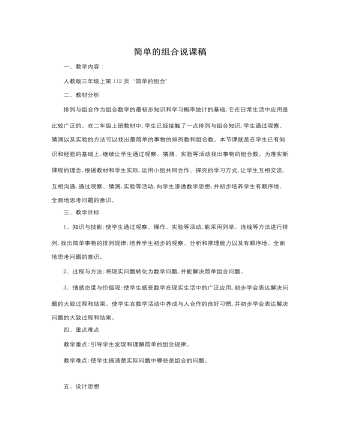
人教版新课标小学数学三年级上册简单的组合说课稿
6、解决问题全班共要握:44+43+……+2+1=990(次)7、揭题:我们生活中寻常的握手就用到我们数学的《简单的组合》三、应用规律解决问题1、02年世界杯背景简单介绍。例3:(出示图片)世界杯足球赛是全世界足球爱好者四年一度的足球盛宴。2002年世界杯将为历史写下新的一页:这是世界杯史上第一次由两个国家(韩国和日本)共同主办的大型单项锦标赛。2002年世界杯对全世界华人来说,也是个值得骄傲的日子,中国国家男子足球队第一次闯进世界杯决赛圈。中国队将在小组赛上对阵巴西队、哥斯达黎加队、土耳其队。理解题意:2002年世界杯足球赛C组球队如下:巴西、土尔其、中国、哥斯达黎加。要求每两个球队踢一场,问我们一共要踢多少场?2、数线段:(1)线段上共有10个点,共有多少条线段?
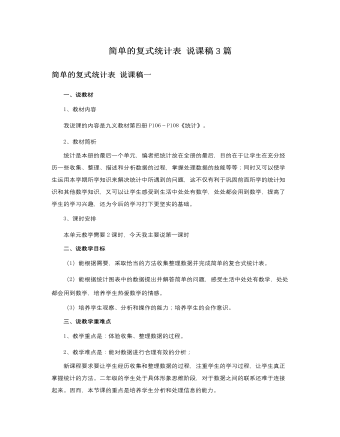
人教版新课标小学数学二年级下册简单的复式统计表说课稿3篇
3、教材结构分析教材内容可以看出,本节课包含四个知识的内容。即调查入学时的体重情况填写统计表;收集现在(二年级)的体重情况填写统计表;把入学以及现在的体重情况统一填写到同一个统计表中;整理、分析表内信息回答简单的问题。但从本地学生情况实际出发,以及条件的限制,所以本人对教材内容进行了略微的调整,将调查入学时的体重情况填写统计表改为统计本地区天气情况,也与现实生活紧密地联系在一起。同时,按照教材的逻辑性将知识整合在新课程改革的目标中。4、教学目标(1)知识目标:能运用信息的手段、新的学习方法收集整理数据完成简单的复合式统计图。(2)情感目标:能根据统计图表中的数据提出并解答简单的问题,感受生活中处处有数学,结合实例有机地进行家乡情的教育。
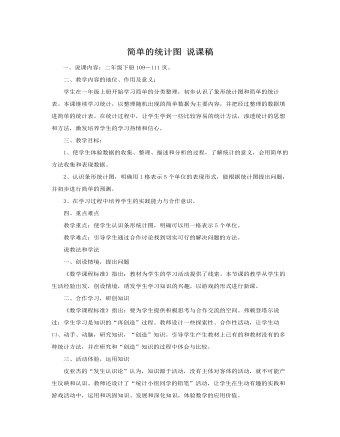
人教版新课标小学数学二年级下册简单的统计图说课稿
学生在一年级上册开始学习简单的分类整理,初步认识了象形统计图和简单的统计表。本课继续学习统计,以整理随机出现的简单数据为主要内容,并把经过整理的数据填进简单的统计表。在统计过程中,让学生学到一些比较容易的统计方法,渗透统计的思想和方法,激发培养学生的学习热情和信心。三、教学目标:1、使学生体验数据的收集、整理、描述和分析的过程,了解统计的意义,会用简单的方法收集和表现数据。2、认识条形统计图,明确用1格表示5个单位的表现形式,能根据统计图提出问题,并初步进行简单的预测。3、在学习过程中培养学生的实践能力与合作意识。四、重点难点教学重点:使学生认识条形统计图,明确可以用一格表示5个单位。教学难点:引导学生通过合作讨论找到切实可行的解决问题的方法。
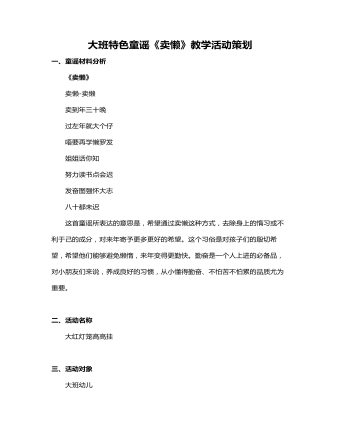
《卖懒》教学设计教案
1.制作红灯笼师:(展示漂亮的灯笼)小朋友们想不想自己亲手制作一个呢?生:好呀师:那小朋友们知道制作灯笼需要什么材料吗?生:彩纸、剪刀...师:没错,那老师先来展示一下怎么制作灯笼吧!(展示完后,开始让小朋友两两组合共同制作)2.制作灯笼剪纸师:小朋友们,刚刚是不是已经制作灯笼了呀?下面我们进行一个更好玩的环节?生:好呀好呀!师:那我先来展示一下咯,小朋友们别眨眼呀!(展示完后,开始让小朋友们独立完成)小结:通过制作共同合作制作灯笼与独自完成灯笼剪影,不仅使他们更能感知灯笼的形状,更能提高小朋友们的动手能力和思考力。
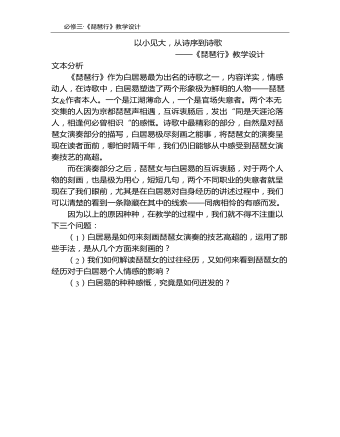
《琵琶行》教学设计
文本分析《琵琶行》作为白居易最为出名的诗歌之一,内容详实,情感动人,在诗歌中,白居易塑造了两个形象极为鲜明的人物——琵琶女&作者本人。一个是江湖薄命人,一个是官场失意者。两个本无交集的人因为京都琵琶声相遇,互诉衷肠后,发出“同是天涯沦落人,相逢何必曾相识“的感慨
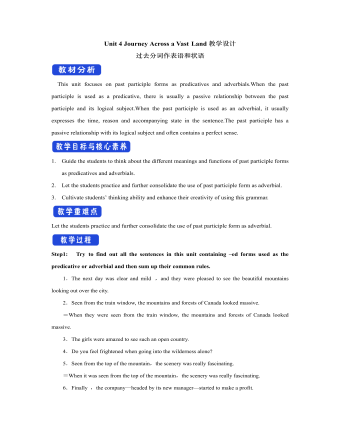
新人教版高中英语选修2Unit 4 Journey Across a Vast Land教学设计
当孩子们由父母陪同时,他们才被允许进入这个运动场。3.过去分词(短语)作状语时的几种特殊情况(1)过去分词(短语)在句中作时间、条件、原因、让步状语时,相当于对应的时间、条件、原因及让步状语从句。Seen from the top of the mountain (=When it is seen from the top of the mountain), the whole town looks more beautiful.从山顶上看,整个城市看起来更美了。Given ten more minutes (=If we are given ten more minutes), we will finish the work perfectly.如果多给十分钟,我们会完美地完成这项工作。Greatly touched by his words (=Because she was greatly touched by his words), she was full of tears.由于被他的话深深地感动,她满眼泪花。Warned of the storm (=Though they were warned of the storm), the farmers were still working on the farm.尽管被警告了风暴的到来,但农民们仍在农场干活。(2)过去分词(短语)在句中作伴随、方式等状语时,可改为句子的并列谓语或改为并列分句。The teacher came into the room, followed by two students (=and was followed by two students).后面跟着两个学生,老师走进了房间。He spent the whole afternoon, accompanied by his mom(=and was accompanied by his mom).他由母亲陪着度过了一整个下午。
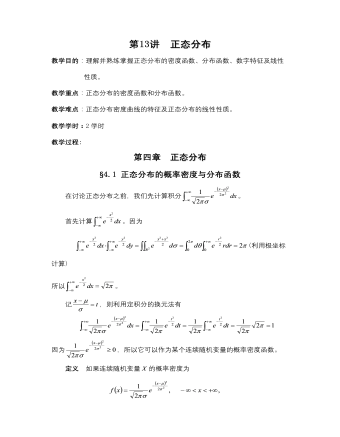
【高教版】中职数学拓展模块:3.5《正态分布》教学设计
教学目的:理解并熟练掌握正态分布的密度函数、分布函数、数字特征及线性性质。教学重点:正态分布的密度函数和分布函数。教学难点:正态分布密度曲线的特征及正态分布的线性性质。教学学时:2学时教学过程:第四章 正态分布§4.1 正态分布的概率密度与分布函数在讨论正态分布之前,我们先计算积分。首先计算。因为(利用极坐标计算)所以。记,则利用定积分的换元法有因为,所以它可以作为某个连续随机变量的概率密度函数。定义 如果连续随机变量的概率密度为则称随机变量服从正态分布,记作,其中是正态分布的参数。正态分布也称为高斯(Gauss)分布。
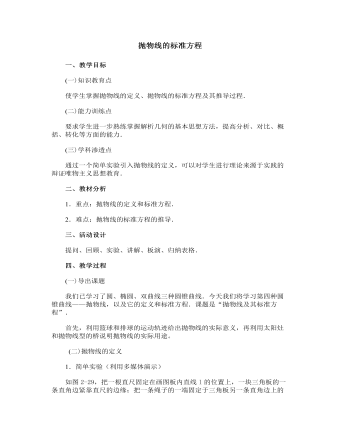
【高教版】中职数学拓展模块:2.3《抛物线》教学设计
一、教学目标(一)知识教育点使学生掌握抛物线的定义、抛物线的标准方程及其推导过程.(二)能力训练点要求学生进一步熟练掌握解析几何的基本思想方法,提高分析、对比、概括、转化等方面的能力.(三)学科渗透点通过一个简单实验引入抛物线的定义,可以对学生进行理论来源于实践的辩证唯物主义思想教育.二、教材分析1.重点:抛物线的定义和标准方程.2.难点:抛物线的标准方程的推导.三、活动设计提问、回顾、实验、讲解、板演、归纳表格.四、教学过程(一)导出课题我们已学习了圆、椭圆、双曲线三种圆锥曲线.今天我们将学习第四种圆锥曲线——抛物线,以及它的定义和标准方程.课题是“抛物线及其标准方程”.首先,利用篮球和排球的运动轨迹给出抛物线的实际意义,再利用太阳灶和抛物线型的桥说明抛物线的实际用途。
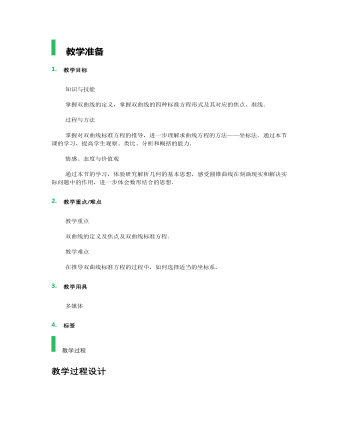
【高教版】中职数学拓展模块:2.2《双曲线》教学设计
教学准备 1. 教学目标 知识与技能掌握双曲线的定义,掌握双曲线的四种标准方程形式及其对应的焦点、准线.过程与方法掌握对双曲线标准方程的推导,进一步理解求曲线方程的方法——坐标法.通过本节课的学习,提高学生观察、类比、分析和概括的能力.情感、态度与价值观通过本节的学习,体验研究解析几何的基本思想,感受圆锥曲线在刻画现实和解决实际问题中的作用,进一步体会数形结合的思想.2. 教学重点/难点 教学重点双曲线的定义及焦点及双曲线标准方程.教学难点在推导双曲线标准方程的过程中,如何选择适当的坐标系. 3. 教学用具 多媒体4. 标签
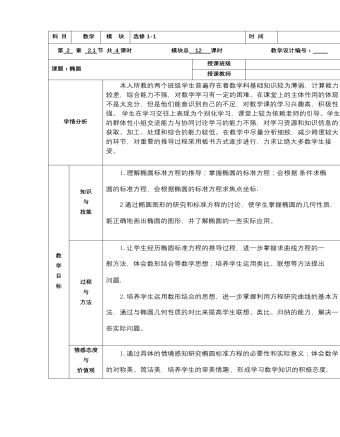
【高教版】中职数学拓展模块:2.1《椭圆》优秀教学设计
本人所教的两个班级学生普遍存在着数学科基础知识较为薄弱,计算能力较差,综合能力不强,对数学学习有一定的困难。在课堂上的主体作用的体现不是太充分,但是他们能意识到自己的不足,对数学课的学习兴趣高,积极性强。 学生在学习交往上表现为个别化学习,课堂上较为依赖老师的引导。学生的群体性小组交流能力与协同讨论学习的能力不强,对学习资源和知识信息的获取、加工、处理和综合的能力较低。在教学中尽量分析细致,减少跨度较大的环节,对重要的推导过程采用板书方式逐步进行,力求让绝大多数学生接受。 1.理解椭圆标准方程的推导;掌握椭圆的标准方程;会根据条件求椭圆的标准方程,会根据椭圆的标准方程求焦点坐标. 2.通过椭圆图形的研究和标准方程的讨论,使学生掌握椭圆的几何性质,能正确地画出椭圆的图形,并了解椭圆的一些实际应用。 1.让学生经历椭圆标准方程的推导过程,进一步掌握求曲线方程的一般方法,体会数形结合等数学思想;培养学生运用类比、联想等方法提出问题. 2.培养学生运用数形结合的思想,进一步掌握利用方程研究曲线的基本方法,通过与椭圆几何性质的对比来提高学生联想、类比、归纳的能力,解决一些实际问题。 1.通过具体的情境感知研究椭圆标准方程的必要性和实际意义;体会数学的对称美、简洁美,培养学生的审美情趣,形成学习数学知识的积极态度. 2.进一步理解并掌握代数知识在解析几何运算中的作用,提高解方程组和计算能力,通过“数”研究“形”,说明“数”与“形”存在矛盾的统一体中,通过“数”的变化研究“形”的本质。帮助学生建立勇于探索创新的精神和克服困难的信心。
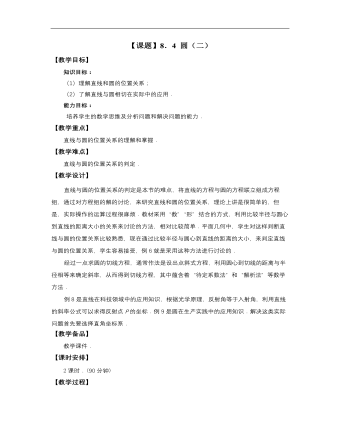
高教版中职数学基础模块下册:8.4《圆》教学设计
教 学 过 程教师 行为学生 行为教学 意图时间 *揭示课题 8.4 圆(二) *创设情境 兴趣导入 【知识回顾】 我们知道,平面内直线与圆的位置关系有三种(如图8-21): (1)相离:无交点; (2)相切:仅有一个交点; (3)相交:有两个交点. 并且知道,直线与圆的位置关系,可以由圆心到直线的距离d与半径r的关系来判别(如图8-22): (1):直线与圆相离; (2):直线与圆相切; (3):直线与圆相交. 介绍 讲解 说明 质疑 引导 分析 了解 思考 思考 带领 学生 分析 启发 学生思考 0 15*动脑思考 探索新知 【新知识】 设圆的标准方程为 , 则圆心C(a,b)到直线的距离为 . 比较d与r的大小,就可以判断直线与圆的位置关系. 讲解 说明 引领 分析 思考 理解 带领 学生 分析 30*巩固知识 典型例题 【知识巩固】 例6 判断下列各直线与圆的位置关系: ⑴直线, 圆; ⑵直线,圆. 解 ⑴ 由方程知,圆C的半径,圆心为. 圆心C到直线的距离为 , 由于,故直线与圆相交. ⑵ 将方程化成圆的标准方程,得 . 因此,圆心为,半径.圆心C到直线的距离为 , 即由于,所以直线与圆相交. 【想一想】 你是否可以找到判断直线与圆的位置关系的其他方法? *例7 过点作圆的切线,试求切线方程. 分析 求切线方程的关键是求出切线的斜率.可以利用原点到切线的距离等于半径的条件来确定. 解 设所求切线的斜率为,则切线方程为 , 即 . 圆的标准方程为 , 所以圆心,半径. 图8-23 圆心到切线的距离为 , 由于圆心到切线的距离与半径相等,所以 , 解得 . 故所求切线方程(如图8-23)为 , 即 或. 说明 例题7中所使用的方法是待定系数法,在利用代数方法研究几何问题中有着广泛的应用. 【想一想】 能否利用“切线垂直于过切点的半径”的几何性质求出切线方程? 说明 强调 引领 讲解 说明 引领 讲解 说明 观察 思考 主动 求解 思考 主动 求解 通过例题进一步领会 注意 观察 学生 是否 理解 知识 点 50
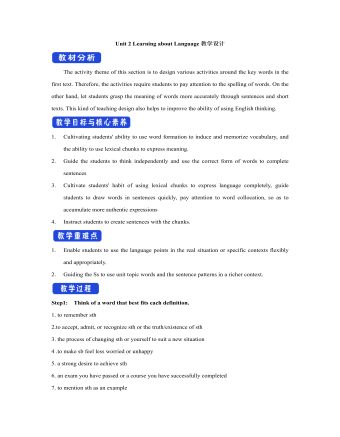
新人教版高中英语选修2Unit 2 Learning about Language教学设计
The activity theme of this section is to design various activities around the key words in the first text. Therefore, the activities require students to pay attention to the spelling of words. On the other hand, let students grasp the meaning of words more accurately through sentences and short texts. This kind of teaching design also helps to improve the ability of using English thinking.1. Cultivating students' ability to use word formation to induce and memorize vocabulary, and the ability to use lexical chunks to express meaning.2. Guide the students to think independently and use the correct form of words to complete sentences3. Cultivate students' habit of using lexical chunks to express language completely, guide students to draw words in sentences quickly, pay attention to word collocation, so as to accumulate more authentic expressions4. Instruct students to create sentences with the chunks.1. Enable students to use the language points in the real situation or specific contexts flexibly and appropriately.2. Guiding the Ss to use unit topic words and the sentence patterns in a richer context.Step1: Think of a word that best fits each definition.1. to remember sth2.to accept, admit, or recognize sth or the truth/existence of sth3. the process of changing sth or yourself to suit a new situation4 .to make sb feel less worried or unhappy5. a strong desire to achieve sth
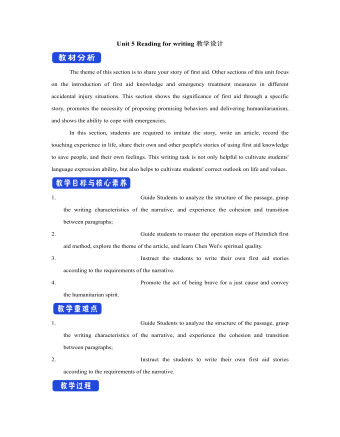
新人教版高中英语选修2Unit 5 Reading for writing教学设计
你校英语报计划出版一期急救常识专刊,现面向全校学生公开征集稿件,你有意参加。请你根据下面提示内容,用英语写一篇短文,介绍在车祸现场对伤者进行急救的方法和步骤。1.确保现场的安全;2.询问伤者,确保其呼吸正常;3.检查伤口,如流血则应采取止血措施;4.如需急救,确保其处于康复位置。注意:1.词数80左右;2.可以适当增加细节,以使行文连贯。参考词汇:康复位置 recovery positionAs we all know, having a knowledge of first aid can make a great difference in our daily life. If a traffic accident happens and someone is injured, the following steps can be used to treat the injured.In the first place, we should make sure that the accident scene is safe so that we won’t get hurt. We should ask the injured person if he is OK, and see if he is breathing. What’s more, we should check for cuts and wounds. If he is bleeding badly, it is vital that we should try to stop the bleeding by applying pressure to the injury. This is because if a person loses too much blood, he may die. If necessary, take the injured person to the hospital as soon as possible.Do remember: when giving first aid, please be sure to place the person in a recovery position.
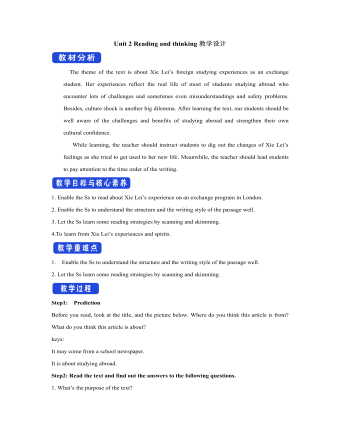
新人教版高中英语选修2Unit 2 Reading and thinking教学设计
Her tutor told her to acknowledge __________ other people had said if she cited their ideas, and advised her _______(read) lots of information in order to form __________wise opinion of her own.Now halfway __________ her exchange year, Xie Lei felt much more at home in the UK. She said __________ (engage) in British culture had helped and that she had been__________ (involve) in social activities. She also said while learning about business, she was acting as a cultural messenger __________(build) a bridge between the two countries. keys:Xie Lei, a 19yearold Chinese student, said goodbye to her family and friends in China and boarded (board) a plane for London six months ago in order to get a business qualification. She was ambitious(ambition) to set up a business after graduation. It was the first time that she had left (leave) home.At first, Xie Lei had to adapt to life in a different country. She chose to live with a host family, who can help with her adaptation (adapt) to the new culture. When she missed home, she felt comforted (comfort) to have a second family. Also Xie Lei had to satisfy academic requirements. Her tutor told her to acknowledge what other people had said if she cited their ideas, and advised her to read lots of information in order to form a wise opinion of her own.Now halfway through her exchange year, Xie Lei felt much more at home in the UK. She said engaging (engage) in British culture had helped and that she had been involved (involve) in social activities. She also said while learning about business, she was acting as a cultural messenger building a bridge between the two countries.
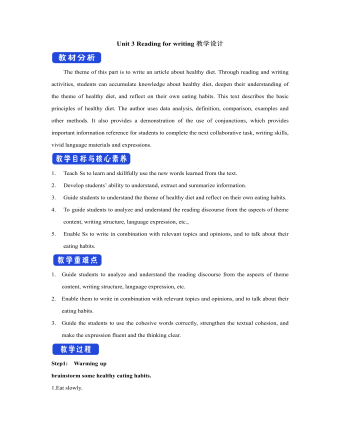
新人教版高中英语选修2Unit 3 Reading for writing教学设计
The theme of this part is to write an article about healthy diet. Through reading and writing activities, students can accumulate knowledge about healthy diet, deepen their understanding of the theme of healthy diet, and reflect on their own eating habits. This text describes the basic principles of healthy diet. The author uses data analysis, definition, comparison, examples and other methods. It also provides a demonstration of the use of conjunctions, which provides important information reference for students to complete the next collaborative task, writing skills, vivid language materials and expressions.1. Teach Ss to learn and skillfully use the new words learned from the text.2. Develop students’ ability to understand, extract and summarize information.3. Guide students to understand the theme of healthy diet and reflect on their own eating habits.4. To guide students to analyze and understand the reading discourse from the aspects of theme content, writing structure, language expression, etc., 5. Enable Ss to write in combination with relevant topics and opinions, and to talk about their eating habits.1. Guide students to analyze and understand the reading discourse from the aspects of theme content, writing structure, language expression, etc.2. Enable them to write in combination with relevant topics and opinions, and to talk about their eating habits.3. Guide the students to use the cohesive words correctly, strengthen the textual cohesion, and make the expression fluent and the thinking clear.Step1: Warming upbrainstorm some healthy eating habits.1.Eat slowly.2.Don’t eat too much fat or sugar.3.Eat healthy food.4.Have a balanced diet.Step2: Read the passage and then sum up the main idea of each paragraph.
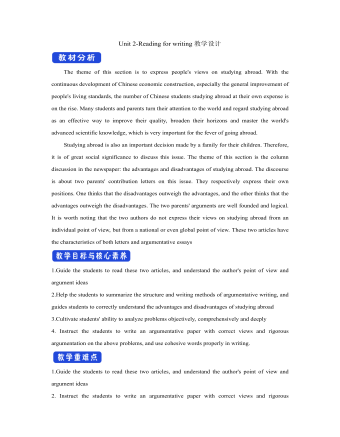
新人教版高中英语选修2Unit 2 Reading for writing教学设计
The theme of this section is to express people's views on studying abroad. With the continuous development of Chinese economic construction, especially the general improvement of people's living standards, the number of Chinese students studying abroad at their own expense is on the rise. Many students and parents turn their attention to the world and regard studying abroad as an effective way to improve their quality, broaden their horizons and master the world's advanced scientific knowledge, which is very important for the fever of going abroad. Studying abroad is also an important decision made by a family for their children. Therefore, it is of great social significance to discuss this issue. The theme of this section is the column discussion in the newspaper: the advantages and disadvantages of studying abroad. The discourse is about two parents' contribution letters on this issue. They respectively express their own positions. One thinks that the disadvantages outweigh the advantages, and the other thinks that the advantages outweigh the disadvantages. The two parents' arguments are well founded and logical. It is worth noting that the two authors do not express their views on studying abroad from an individual point of view, but from a national or even global point of view. These two articles have the characteristics of both letters and argumentative essays1.Guide the students to read these two articles, and understand the author's point of view and argument ideas2.Help the students to summarize the structure and writing methods of argumentative writing, and guides students to correctly understand the advantages and disadvantages of studying abroad3.Cultivate students' ability to analyze problems objectively, comprehensively and deeply





















